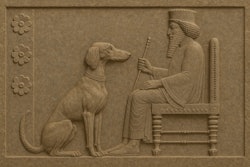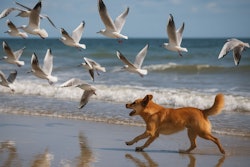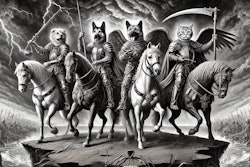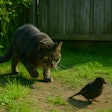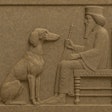
Vikings may have spread cats, especially orange or calico-furred felines, as the Norse raiders conquered and colonized coastal Europe. Since the 1977 publication of “Cats and Commerce” in Scientific American, researchers have speculated that human migration patterns can be followed by observing the spread of cats. For example, orange and tortoiseshell cats may have originated near Egypt and spread by land around the Middle East and North Africa. However, the prevalence of orange cats dropped dramatically west of Anatolia. Surprisingly, the genes for orange or calico cats reappeared in England, Brittany, Normandy and other parts of Northern Europe. Scientists believe these cats may have descended from felines adopted by Vikings as they traded and raided in the area around the Black Sea. Viking cats present a rich opportunity for cat food companies to develop marketing campaigns grounded in both history and science.
Cat genetics and Viking expansion
In a paper published in Nature in 2016, researchers reported their results after sequencing the DNA of 209 cats found at archeological sites dating from 15,000 to 2,700 years ago. Cats seem to have spread from their Middle Eastern homeland in two waves. The first domestic cats may have followed the spread of agriculture from Mesopotamia to Egypt, Greece, Cyprus and other parts of the ancient eastern Mediterranean. The second wave of cats may have been mousers employed to control mice on ships, which is where the Vikings came in. For example, the genetic analysis identified a DNA variant in an Egyptian cat that matched the genetic profile of a cat discovered at a Viking site in Germany. These medieval Scandinavian cat fanciers seem to have shown a preference for orange and calico cats.
Genetically, ginger fur arose due to a mutation near the ARHGAP36 gene on the X chromosome, according to research published in Current Biology. This mutation shifted pigment production toward pheomelanin, resulting in red or orange fur. Since males have one X chromosome, the trait appears consistently in orange males, while females tend to express the mutation as tortoiseshell and calico patterns, like my own cat, Tigra. Although these genetic discoveries come from studies of modern cats, they align with the medieval distribution of orange cats in Viking regions, suggesting that ancient Viking voyages contributed to the geographical expansion of orange coat genes.
Along with Viking ships, cats even made their way into Norse mythology. Freya, the goddess of love, beauty and fertility, traveled in a chariot pulled by two enormous cats. Although sacred, medieval Scandinavians didn’t hesitate to make economic use of cats. Some cats’ bones from Viking sites show cut marks indicative of skinning for pelts. Meanwhile, other cats appear to have been valued companions or talismans, as suggested by their inclusion in ritual deposits. Cat bones have been discovered in refuse pits, sacrificial sites and elite burials in Scandinavia, as well as in Norse-occupied territories in the British Isles.
Marketing cat food using Viking imagery
Cats’ Norse associations opens another realm of marketing imagery for cat foods and treats. Like marketing that equates wolves with dogs, Viking-themed cat marketing could present a different side of the predators that stalk our cardboard boxes. By putting some meow in Mjölnir, cat food brands could differentiate themselves by using this narrative to build a premium product line or limited-edition offering that emphasizes natural ancestry, exploration and resilience. For example, a company could launch a Viking Origins formula featuring high-protein ingredients reminiscent of traditional Nordic diets, such as salmon, herring or venison, paired with messaging that celebrates the rugged spirit of early feline companions. Packaging might depict stylized longships or Norse motifs alongside educational content on the genetic legacy of orange cats. Freya’s cat-drawn chariot could similarly become the center of a cat food advertisement.
Beyond product development, the story lends itself to engaging social media campaigns, influencer partnerships and interactive consumer content. Brands could encourage cat owners to share photos of orange or tortoiseshell cats under a themed hashtag, such as #VikingCat, or explore interactive tools linking feline coat color to historical migration paths. For pet food marketers seeking to connect emotionally with consumers, particularly those interested in ancestry, genetics or Nordic mythology, this blend of historical depth and scientific credibility offers a compelling branding angle. That said, it’s also important to remember that, although Vikings could be peaceful farmers, many Norse raiders built their economy on slave trading, robbery and mercenary activities. Like cats, Viking were complex. They combined savage brutality with a penchant for snuggling.
 created by Tim Wall using DALL-E 4
created by Tim Wall using DALL-E 4


